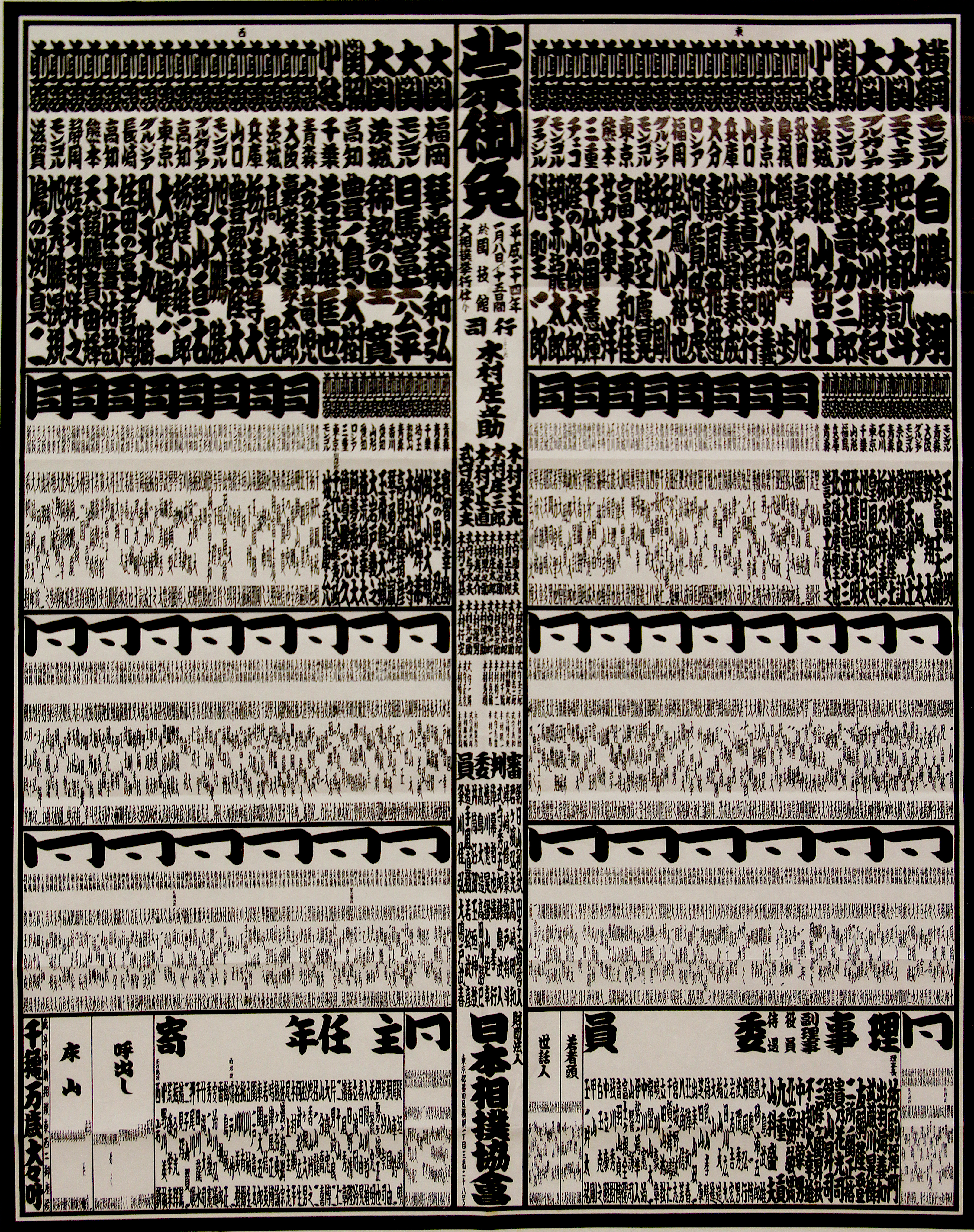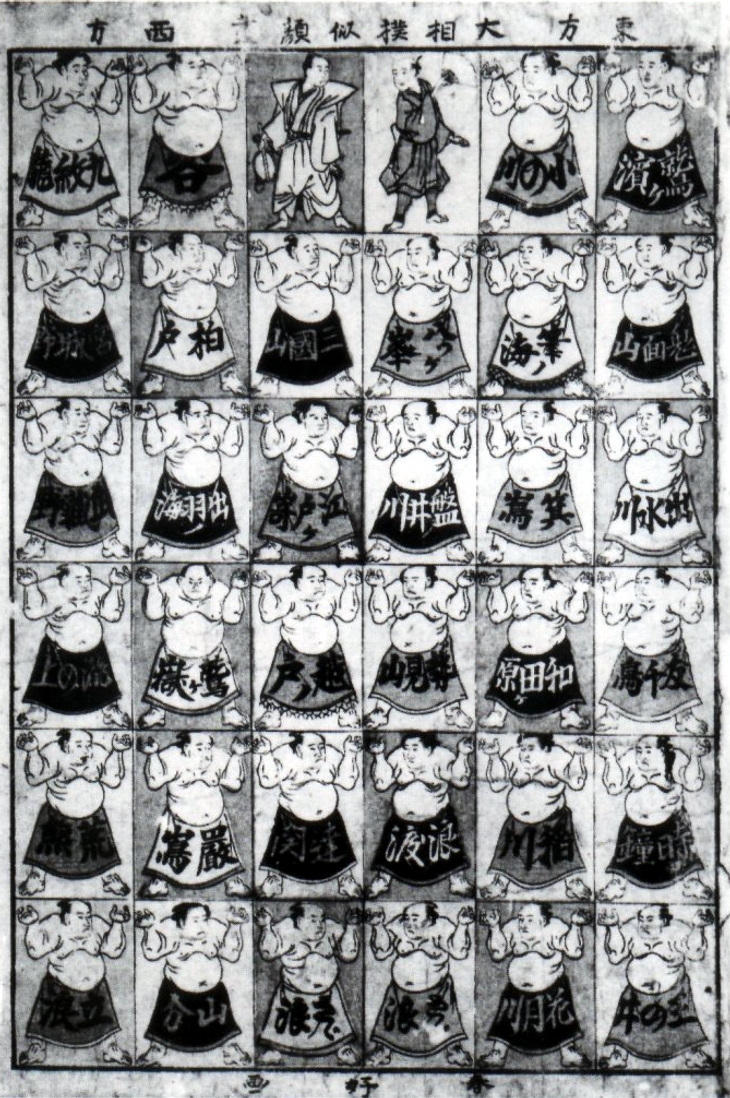|
Banzuke
A , officially called is a document listing the rankings of professional sumo wrestlers published before each official tournament ('' honbasho''). The term can also refer to the rankings themselves. The document is normally released about two weeks before the tournament begins. On the ''banzuke'', wrestlers are divided into East, which is printed on the right, and West, which is printed on the left. Each wrestler's full ''shikona'' (ring name), hometown and rank is also listed. The top of the page starts with the highest ranked ''makuuchi'' wrestlers printed in the largest characters, down to the wrestlers in the lowest divisions which are written in much smaller characters. The names of '' gyōji'' (sumo referees), '' yobidashi'' (ushers/handymen), '' shimpan'' (judges), '' oyakata'' (elders of the Japan Sumo Association), and occasionally ''tokoyama'' (hairdressers) are also listed. While not as old as sumo itself, the form and production of this document can be traced as ... [...More Info...] [...Related Items...] OR: [Wikipedia] [Google] [Baidu] [Amazon] |
Gyōji
A is a referee employed by the Japan Sumo Association, responsible for a variety of activities which concern the organisation of the sport in general and the refereeing of matches, as well as the preservation of Sumo#Professional sumo, professional sumo culture, deeply rooted in Shinto traditions. Subject to the same strict hierarchy and traditional appearance as the other professions gravitating around professional sumo, the are one of the most visible professions at tournaments (), being the third person in the (wrestling ring) and sometimes defined as "an essential part of the sumo spectacle." Inherited from a tradition of refereeing dating back to the Heian period, did not take on their current role until the Tenshō (Momoyama period), Tenshō era in the late 16th century. Since the end of the 18th century, have been entrusted with religious functions, which they perform during the consecration of combat areas, before tournaments or in the heya (sumo), stables to which ... [...More Info...] [...Related Items...] OR: [Wikipedia] [Google] [Baidu] [Amazon] |
Banzuke2
A , officially called is a document listing the rankings of professional sumo wrestlers published before each official tournament (''honbasho''). The term can also refer to the rankings themselves. The document is normally released about two weeks before the tournament begins. On the ''banzuke'', wrestlers are divided into East, which is printed on the right, and West, which is printed on the left. Each wrestler's full ''shikona'' (ring name), hometown and rank is also listed. The top of the page starts with the highest ranked ''makuuchi'' wrestlers printed in the largest characters, down to the wrestlers in the lowest divisions which are written in much smaller characters. The names of ''gyōji'' (sumo referees), ''yobidashi'' (ushers/handymen), '' shimpan'' (judges), '' oyakata'' (elders of the Japan Sumo Association), and occasionally ''tokoyama'' (hairdressers) are also listed. While not as old as sumo itself, the form and production of this document can be traced as fa ... [...More Info...] [...Related Items...] OR: [Wikipedia] [Google] [Baidu] [Amazon] |
Glossary Of Sumo Terms
The following words are terms used in sumo wrestling in Japan. A B C D E F G H I J K M N O R S T W Y Z References External links Glossary of Sumo TermsSumopediaat NHK World-Japan {{Glossaries of ... [...More Info...] [...Related Items...] OR: [Wikipedia] [Google] [Baidu] [Amazon] |
Makuuchi
, or , is the top division of Professional sumo divisions, the six divisions of professional sumo. Its size is fixed at 42 wrestlers (''rikishi''), ordered into five ranks according to their ability as defined by their performance in previous tournaments. This is the only division that is featured on NHK's standard live coverage of sumo tournaments. The lower divisions are shown on their satellite coverage, with only the ''makuuchi'' broadcast having bilingual English commentary. ''Makuuchi'' literally means "inside the curtain", a reference to the early period of professional sumo, when there was a curtained-off area reserved for the top ranked wrestlers, to sit before appearing for their bouts. Wrestlers are considered for Promotion and relegation, promotion or demotion in rank before each grand tournament according to their performance in the one previous. Generally, a greater number of wins than losses (''kachi-koshi'') results in a promotion, and the reverse (''makekoshi ... [...More Info...] [...Related Items...] OR: [Wikipedia] [Google] [Baidu] [Amazon] |
Sumo Terminology
is a form of competitive full-contact wrestling where a ''rikishi'' (wrestler) attempts to force his opponent out of a circular ring (''dohyō'') or into touching the ground with any body part other than the soles of his feet (usually by throwing, shoving or pushing him down). Sumo originated in Japan, the only country where it is practised professionally and where it is considered the national sport. It is considered a ''gendai budō'', which refers to modern Japanese martial arts, but the sport has a history spanning many centuries. Many ancient traditions have been preserved in sumo, and even today the sport includes many ritual elements, such as the use of salt purification, from Shinto. Life as a wrestler is highly regimented, with rules regulated by the Japan Sumo Association. Most sumo wrestlers are required to live in communal sumo training stables, known in Japanese as '' heya'', where all aspects of their daily livesfrom meals to their manner of dressare dictated ... [...More Info...] [...Related Items...] OR: [Wikipedia] [Google] [Baidu] [Amazon] |
Professional Sumo Divisions
Professional sumo as administered by the Japan Sumo Association is divided into six ranked divisions. Wrestlers are promotion and relegation, promoted and demoted within and between these divisions based on the merit of their win–loss records in official tournaments. For more information, see ''kachi-koshi'' and ''make-koshi''. Wrestlers are also ranked within each division. The higher a wrestler's rank within a division is, the general level of opponents he will have to face becomes stronger. According to tradition, each rank is further subdivided into East and West, with East being slightly more prestigious, and ranked slightly higher than its West counterpart. The divisions, ranked in order of hierarchy from highest to lowest, are as follows: ''Makuuchi'' , or , is the top division. It is fixed at 42 wrestlers who are ranked according to their performance in previous tournaments. At the top of the division are the four ranks of "titleholders", or "champions" called the '' ... [...More Info...] [...Related Items...] OR: [Wikipedia] [Google] [Baidu] [Amazon] |
Japan Sumo Association
The , officially the ; sometimes abbreviated JSA or NSK, and more usually called Sumo Kyōkai, is the governing body that operates and controls Professional sports, professional sumo wrestling, called , in Japan under the jurisdiction of the Ministry of Education, Culture, Sports, Science and Technology, Japanese Ministry of Education, Culture, Sports, Science and Technology (MEXT). Concretely, the association maintains and develops sumo traditions and integrity by holding honbasho, tournaments and . The purposes of the association are also to develop the means dedicated to the sport and maintain, manage and operate the facilities necessary for these activities. Therefore, the JSA operates subsidiaries such as the Kokugikan Service Company to organize its economic aspects, the Sumo School to organize training and instruction or the Sumo Museum to preserve and utilize sumo wrestling records and artefacts. Though professionals, such as rikishi, active wrestlers, gyōji, referees, ... [...More Info...] [...Related Items...] OR: [Wikipedia] [Google] [Baidu] [Amazon] |
Honbasho
A , or Grand Sumo Tournament in English, is an official professional sumo tournament. Only ''honbasho'' results matter in determining promotion and relegation for '' rikishi'' (sumo wrestlers) on the '' banzuke'' ranking. The number of ''honbasho'' held every year and their length has varied; since 1958 there are six tournaments held over 15 consecutive days in four locations every year. Since 1926 the ''honbasho'' are organized by the Japan Sumo Association, after the merger of the Tokyo and Osaka sumo associations. Etymology The term ''honbasho'' means "main (or real) tournament" and is used to distinguish these tournaments from unofficial tournaments which are held as part of sumo tours, between the six major tournaments. Such display tournaments may have prize money attached but a wrestler's performance has no effect on his ranking. This type of sumo is often called ''hana-sumo'' ( flower-sumo) as it is not taken as seriously by the wrestlers. History In the Edo period, the ... [...More Info...] [...Related Items...] OR: [Wikipedia] [Google] [Baidu] [Amazon] |
Yobidashi
A , often translated in English as "usher", "ring attendant", or "ring announcer", is an employee of the Japan Sumo Association, responsible for various tasks essential to the traditional running of Sumo#Professional sumo, professional sumo tournaments () in Japan. The are involved in building the (wrestling ring) or calling wrestlers () to the ring when it is their turn to fight. They are also entrusted with other roles, both administrative and artistic, in the service of the heya (sumo), stable to which they are attached. Established during the Heian period, the role of was not codified until the Tenmei, Tenmei era. Nicknamed "sumo's workhorses" by former Takamiyama Daigorō, Takamiyama, the are required to wear traditional clothing in public and are subject to a strict hierarchy in their organisation. History The status of did not appear until 1750. Before the appearance of this term to specifically designate the staff responsible for announcing the wrestlers, several d ... [...More Info...] [...Related Items...] OR: [Wikipedia] [Google] [Baidu] [Amazon] |
Toshiyori
A , also known as an , is a sumo Elder (administrative title), elder exercising both Coach (sport), coaching functions with rikishi, active wrestlers and Management, responsibilities within the Japan Sumo Association (JSA). All are former wrestlers who reached a sufficiently high rank to be eligible to this status. The benefits are considerable, as are guaranteed employment until the mandatory retirement age of 65 and are allowed to run and coach in (sumo stables), with a comfortable yearly salary averaging around Japanese yen, ¥15 million. Originating from a tradition dating back to the Edo period, the position of is founded on a system set up at a time when several sumo associations managed Japan's professional wrestling. To become a , a former wrestler have to meet both established and public criteria and be part of a system recognized as opaque. Involving the spending of several million yen to inherit the rights to become a trainer, this system has undergone numerous ref ... [...More Info...] [...Related Items...] OR: [Wikipedia] [Google] [Baidu] [Amazon] |








